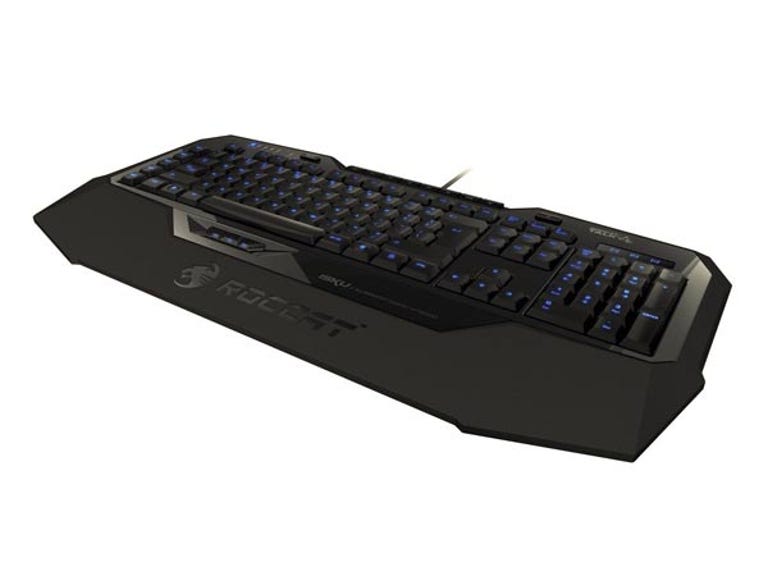 Why You Can Trust CNET
Why You Can Trust CNET Roccat Isku review: Roccat Isku
The Isku is a good gaming keyboard, with very few flaws. We certainly wouldn't complain if this was under our Christmas tree this year.
Our review of Roccat's first keyboard, the Valo, never saw the light of day. Incidentally, neither did the keyboard, thanks to our feedback to the company before its release. It had typomatic issues when it came to macros, transposed keys when typing and often dropped letters. It was hampered by poor key placement, keys getting stuck down, an LCD screen that misreported CPU load at 40 per cent all the time, an incredibly weak backlight, a poorly placed in-built microphone and emitted a persistent electronic whine.
The Good
The Bad
The Bottom Line
In short, it was really very bad, a departure from Roccat's other products. So it was with some trepidation that we took delivery of the Isku, a less ambitious keyboard for sure, but perhaps one where a whole lot less can go wrong.
The good news is that none of the above problems plague the Isku at all. Its blue backlighting is pleasant and strong, although another colour would have aided in the readability of the letters. There are no issues with dropped or swapped letters. The typomatic delay of the macro keys is gone. In fact, the only real issue we could find is hitting "Apply" after changing settings in the driver panel takes an extraordinarily long time, to the point that Windows 7 thinks the application has crashed. This is apparently related to some antivirus tools, and switching to another machine made this go away completely. It's worth noting these settings are saved directly to the keyboard itself — when we loaded the driver on the new machine, the key maps were still intact.
The keyboard itself has sharp, militarised corners, an expansive sloped wrist rest and silky keys. These take a little getting used to, but once you're there they're as equal to the task as any other keyboard. It feels very much like a slightly cut down version of Microsoft's SideWinder X6.
There are five programmable keys to the left, a set of media buttons at the top and a dedicated button for adjusting the backlight across five levels, although the final two levels are almost impossible to tell apart. You'll want to leave the light on, as the buttons are dull and quite hard to read. If you're worried about energy expenditure, there's an option in the driver to dull the lights after a given time period.
There are also custom buttons under the spacebar, one for opening the Roccat driver, the others for profile switching, accompanied by Roccat's hilarious voiceover man booming over your speaker's "profile 1!", "profile 2!" and so on. Thankfully, you can turn this off. As is the case with gaming gear, each profile can contain a distinct set of customised keys, so you can adjust your keyboard layout depending on the game.
The caps lock key may not act as you expect, though: by default it is assigned to Roccat's EasyShift function. Hold it down, and all the M buttons, along with the buttons under the spacebar will be assigned a secondary function, all of which can be customised by the user. Considering how sparingly caps lock is used, it's not a bad compromise for extra functionality.
If you happen to own a Kone[+] mouse, it's possible for the Isku and Kone[+] to talk to each other through something called Roccat Talk. The EasyShift button on the keyboard can affect the mouse, keyboard or both simultaneously, allowing for some pretty flexible customisation. Better, though, is that it incorporates our favourite feature from the R.A.T. 7 — hold down a key on the keyboard and your mouse speed will be reduced, allowing for more accurate sniper shots. Something that isn't made immediately obvious: you'll need a separate Roccat Talk driver for all this to work.
The EasyShift button can also affect the "EasyZone" series of keys if enabled, which consists of pretty much every key your left hand is able to reach while still holding the caps lock button: 1-5, Q-T, A-G, Z-B. Along with custom assignments, this should help negate keyboard sprawl that affects more complex games.
Macro editing is identical to Roccat's mice, and is quite a decent set-up, even allowing you to live record through a button on the keyboard. However, if you do things this way, delays will be recorded as well.
For those who are annoyed by Windows' function keys, you can turn off the Windows key, application key, tab key and left shift key individually if you so desire, thereby removing all keys that could be responsible for dumping you out of game and back to the desktop.
The Isku is a good gaming keyboard, with very few flaws. We certainly wouldn't complain if this was under our Christmas tree this year.


